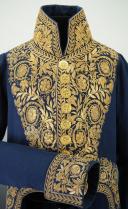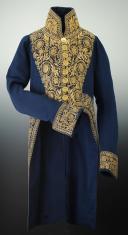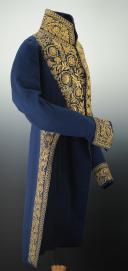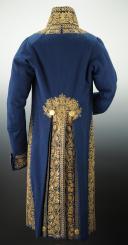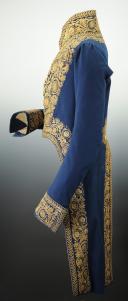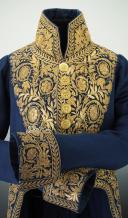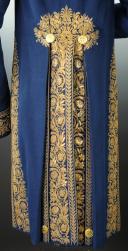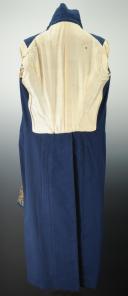
Grand Uniform of the Chamberlain of the Crown, Restoration period (1814-1830)
Sold out
GRAND CHAMBERLAIN'S GRAND UNIFORM, RESTORATION PERIOD (1814-1830).
Uniform made of blue wool closing straight down the front with nine large gilt brass buttons stamped with the key of the chamberlains surrounded by two fleurs-de-lis and topped with the Royal crown, bordered by two laurel branches.
The uniform is lavishly embroidered with gold threads, bullion, and sequins depicting branches of scabious leaves across the entire front panel, collar, and cuffs, as well as around the edges of the uniform. A fleur-de-lis is embroidered on each side of the collar. The cuffs close with small wooden buttons covered in blue wool. At the back, two large uniform buttons are sewn at the bottom of the back and one on each tail.
In perfect condition, the embroideries are exceptionally well-preserved, almost like new.
Restoration Period (1814-1830).
Note: Before the creation of the position of Grand Chamberlain of France, there were chamberlains of the king, such as Jean de Gaillonet, a knight who married Marguerite de Meudon.
Creation of the position of Grand Chamberlain of France:
The office was very ancient, as it was a sort of fusion between that of a chamberlain proper and that of a chamberlain, which was abolished by King Francis I in October 1545. The Grand Chamberlain of France held importance due to having permanent access to the king's chamber, symbolized by the golden key he carried at his side, which became the heraldic emblem of the dignity of the Grand Chamberlains: they wore two golden keys, with rings ending in a royal crown, in saltire behind their personal arms.
Its original role was the direction of the king's chamber and wardrobe. This office provided very close proximity to the royal person and was entrusted to counselors close to the sovereign. Thus, during the reign of Louis XIV, the Grand Chamberlain held the second rank in ambassador receptions, served the king at the table, and presented his shirt to him at his rising.
The Grand Chamberlain signed charters and important documents and sat with the king in the judgment of the peers. He held the secret seal and the cabinet seal, received oaths of fidelity to the Crown, and oversaw them in the presence of the King. His essential function was his role during the coronation.
On the day of the coronation, he was responsible for receiving the peers in the King's Chamber: the ecclesiastical peers knocked on the closed door, the Grand Chamberlain asked them what they sought, and the peers replied that they sought the king. The Grand Chamberlain then opened the door. During...
(Continued in next message)
Uniform made of blue wool closing straight down the front with nine large gilt brass buttons stamped with the key of the chamberlains surrounded by two fleurs-de-lis and topped with the Royal crown, bordered by two laurel branches.
The uniform is lavishly embroidered with gold threads, bullion, and sequins depicting branches of scabious leaves across the entire front panel, collar, and cuffs, as well as around the edges of the uniform. A fleur-de-lis is embroidered on each side of the collar. The cuffs close with small wooden buttons covered in blue wool. At the back, two large uniform buttons are sewn at the bottom of the back and one on each tail.
In perfect condition, the embroideries are exceptionally well-preserved, almost like new.
Restoration Period (1814-1830).
Note: Before the creation of the position of Grand Chamberlain of France, there were chamberlains of the king, such as Jean de Gaillonet, a knight who married Marguerite de Meudon.
Creation of the position of Grand Chamberlain of France:
The office was very ancient, as it was a sort of fusion between that of a chamberlain proper and that of a chamberlain, which was abolished by King Francis I in October 1545. The Grand Chamberlain of France held importance due to having permanent access to the king's chamber, symbolized by the golden key he carried at his side, which became the heraldic emblem of the dignity of the Grand Chamberlains: they wore two golden keys, with rings ending in a royal crown, in saltire behind their personal arms.
Its original role was the direction of the king's chamber and wardrobe. This office provided very close proximity to the royal person and was entrusted to counselors close to the sovereign. Thus, during the reign of Louis XIV, the Grand Chamberlain held the second rank in ambassador receptions, served the king at the table, and presented his shirt to him at his rising.
The Grand Chamberlain signed charters and important documents and sat with the king in the judgment of the peers. He held the secret seal and the cabinet seal, received oaths of fidelity to the Crown, and oversaw them in the presence of the King. His essential function was his role during the coronation.
On the day of the coronation, he was responsible for receiving the peers in the King's Chamber: the ecclesiastical peers knocked on the closed door, the Grand Chamberlain asked them what they sought, and the peers replied that they sought the king. The Grand Chamberlain then opened the door. During...
(Continued in next message)
Reference :
240
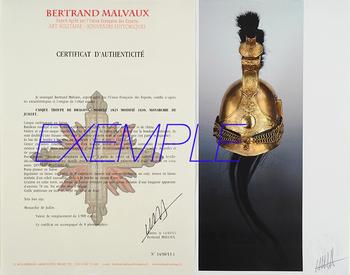
Next update Friday, april 4th at 1:30 PM
FOR ALL PURCHASES, PAYMENT IN MULTIPLE CHECKS POSSIBLE
bertrand.malvaux@wanadoo.fr 06 07 75 74 63
An authenticity certificate of the item including the description published on the site, the period, the sale price, accompanied by one or more color photographs is automatically provided for any item priced over 130 euros. Below this price, each certificate is charged 5 euros.
Only items sold by me are subject to an authenticity certificate, I do not provide any expert reports for items sold by third parties (colleagues or collectors).
